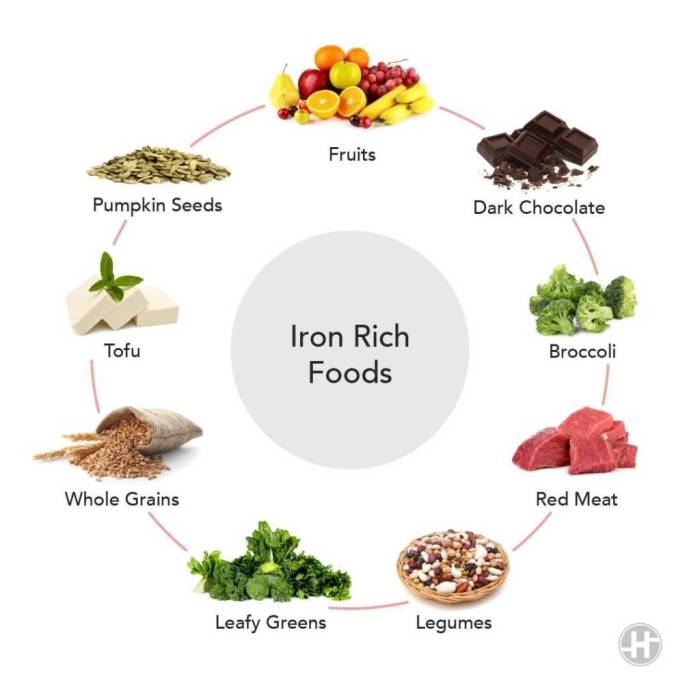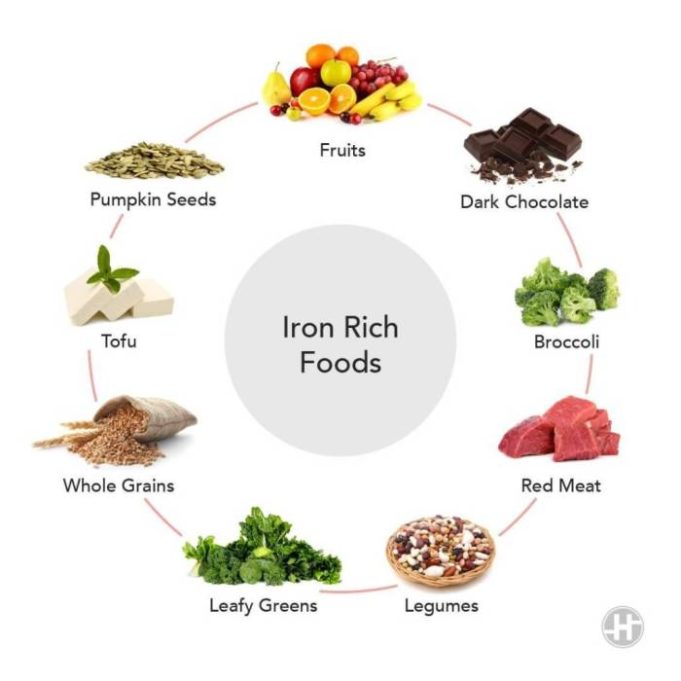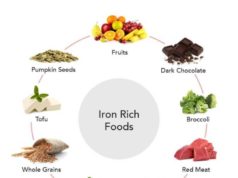How to get more iron in my diet – How to get more iron in your diet is a question many of us ponder, especially when we’re feeling tired or run down. Iron is a vital mineral that plays a crucial role in carrying oxygen throughout the body, supporting energy production, and contributing to overall health. Iron deficiency, also known as anemia, can lead to fatigue, weakness, and other symptoms. Fortunately, by incorporating iron-rich foods into your diet and understanding how to enhance absorption, you can effectively increase your iron levels and improve your well-being.
This guide will delve into the importance of iron, explore the best dietary sources, and provide practical tips for maximizing iron absorption. We’ll also discuss the role of supplements and offer advice on when to consult a healthcare professional. Join us as we uncover the secrets to a more iron-rich and energetic you.
Understanding Iron Deficiency
Iron is an essential mineral that plays a vital role in various bodily functions, including oxygen transport, energy production, and cell growth. It is a component of hemoglobin, a protein found in red blood cells that carries oxygen from the lungs to the rest of the body. When the body lacks sufficient iron, it can lead to iron deficiency anemia, a condition characterized by a shortage of red blood cells or hemoglobin.
Symptoms of Iron Deficiency Anemia
Iron deficiency anemia can manifest itself through various symptoms, ranging from mild to severe.
- Fatigue and weakness
- Pale skin
- Shortness of breath
- Headache
- Dizziness
- Cold hands and feet
- Brittle nails
- Hair loss
- Pica (craving non-food items like ice or clay)
These symptoms can significantly impact daily life, affecting energy levels, cognitive function, and overall well-being.
Groups at Higher Risk for Iron Deficiency
Certain groups are more susceptible to iron deficiency due to factors like increased iron requirements, reduced iron absorption, or dietary limitations.
- Infants and young children: Rapid growth and development during these stages necessitate higher iron intake.
- Pregnant women: The fetus requires iron for growth, and the mother’s blood volume increases, leading to higher iron demands.
- Women of childbearing age: Menstrual bleeding can lead to iron loss.
- Vegetarians and vegans: Plant-based diets may be lower in readily absorbed iron.
- Individuals with certain medical conditions: Conditions like celiac disease, inflammatory bowel disease, and chronic kidney disease can interfere with iron absorption.
- People with blood loss: Chronic blood loss from conditions like ulcers, heavy menstrual bleeding, or gastrointestinal bleeding can deplete iron stores.
It is crucial to be aware of these risk factors and consult a healthcare professional if you suspect iron deficiency. Early detection and treatment can prevent complications and improve overall health.
Iron-Rich Foods
Iron is an essential mineral that plays a crucial role in carrying oxygen throughout the body. Iron deficiency, also known as anemia, can lead to fatigue, shortness of breath, and other health problems. To ensure you’re getting enough iron, incorporating iron-rich foods into your diet is essential.
Boosting your iron intake is important for overall health. It’s crucial to focus on a what is good diet that includes iron-rich foods like red meat, leafy greens, and beans. By making these dietary changes, you can ensure your body has the iron it needs to function properly.
Iron-Rich Foods
Iron is found in various foods, both animal and plant-based. Here’s a table highlighting some common iron-rich food sources and their iron content per serving:
| Food Group | Food | Iron (mg) per Serving | Serving Size |
|---|---|---|---|
| Meat | Beef (lean ground) | 3.0 | 3 oz |
| Meat | Chicken (dark meat) | 1.5 | 3 oz |
| Meat | Pork (loin) | 1.8 | 3 oz |
| Seafood | Salmon (canned) | 0.8 | 3 oz |
| Seafood | Tuna (canned) | 1.0 | 3 oz |
| Beans | Kidney beans | 3.4 | 1/2 cup |
| Beans | Black beans | 3.5 | 1/2 cup |
| Legumes | Lentils | 6.6 | 1/2 cup |
| Grains | Enriched bread | 1.0 | 1 slice |
| Grains | Oatmeal | 2.0 | 1/2 cup |
| Vegetables | Spinach | 3.0 | 1 cup |
| Vegetables | Kale | 1.5 | 1 cup |
Plant-Based Iron Sources and Absorption Enhancers
While animal-based sources are generally considered to have higher bioavailability (how well your body absorbs the iron), plant-based sources are still excellent options.
Iron is an essential mineral that helps carry oxygen throughout the body, so it’s important to get enough in your diet. Good sources of iron include red meat, spinach, and beans. While you’re focusing on iron, you might be wondering about the caffeine content in your drinks.
If you’re looking for a caffeine-free option, you might be curious about whether is diet coke caffeine free. Once you’ve addressed your caffeine concerns, you can continue to enjoy a balanced diet rich in iron-rich foods.
Here are some plant-based iron sources and strategies to enhance their absorption:
- Iron-Rich Plant-Based Foods:
- Lentils
- Tofu
- Spinach
- Dried fruits (raisins, apricots)
- Whole grains
- Absorption Enhancers:
- Vitamin C: Consuming foods rich in vitamin C, such as citrus fruits, strawberries, and bell peppers, along with iron-rich meals can significantly enhance iron absorption.
- Meat: Eating iron-rich plant foods with a small amount of meat can improve iron absorption.
Enhancing Iron Absorption: How To Get More Iron In My Diet
While consuming iron-rich foods is crucial, how well your body absorbs iron is equally important. Several factors can influence iron absorption, some enhancing it, while others hinder it.
The Role of Vitamin C in Iron Absorption
Vitamin C, also known as ascorbic acid, plays a vital role in enhancing iron absorption from plant-based sources. It aids in the conversion of non-heme iron, found in plants, to a form that is more readily absorbed by the body. This process is known as “reduction.” When vitamin C is present, it helps reduce iron from its ferric (Fe3+) state to its ferrous (Fe2+) state, making it easier for the body to absorb.
The Impact of Tannins and Phytates on Iron Absorption
Tannins and phytates are compounds found in certain foods that can interfere with iron absorption. These compounds bind to iron in the digestive tract, preventing it from being absorbed by the body.
- Tannins are found in coffee, tea, and red wine.
- Phytates are present in grains, legumes, and nuts.
Tips for Maximizing Iron Absorption from Plant-Based Sources, How to get more iron in my diet
- Pair iron-rich plant foods with vitamin C-rich foods: Combining iron-rich plant foods like spinach, lentils, or tofu with foods rich in vitamin C, such as citrus fruits, strawberries, or bell peppers, can significantly improve iron absorption. For instance, a lentil salad with a lemon vinaigrette or a spinach smoothie with orange juice can boost iron uptake.
- Minimize consumption of tannins and phytates: While completely eliminating these compounds from your diet might be difficult, you can reduce their intake by limiting your consumption of coffee, tea, and red wine, especially during meals. Soaking grains and legumes before cooking can help reduce phytate content.
- Cook with iron cookware: Cooking acidic foods, such as tomato sauce or stews, in cast iron pots can add iron to your meal. Cast iron cookware has a natural iron coating, which releases small amounts of iron into the food during cooking.
Dietary Strategies for Increasing Iron Intake
Increasing iron intake is crucial for individuals with iron deficiency. This can be achieved through strategic dietary choices that incorporate iron-rich foods into your daily meals. A well-planned diet can effectively address iron deficiency and promote overall health.
Incorporating Iron-Rich Foods into Meals
Iron-rich foods can be seamlessly integrated into various meal types, ensuring a consistent intake throughout the day.
- Breakfast: Start your day with a hearty breakfast featuring iron-rich foods. For instance, enjoy a bowl of fortified breakfast cereal with milk and a slice of whole-wheat toast topped with peanut butter, which is a good source of iron. Alternatively, opt for a spinach and feta omelet or a smoothie blended with iron-rich ingredients like spinach, berries, and tofu.
- Lunch: Pack a lunchbox brimming with iron-rich foods. A lentil soup, a salad with chickpeas and spinach, or a whole-wheat sandwich with lean beef or chicken are excellent choices. Consider including a side of iron-rich fruit like dried apricots or prunes.
- Dinner: Dinner is an opportunity to indulge in flavorful iron-rich meals. A stir-fry with tofu, spinach, and mushrooms, a baked salmon with roasted vegetables, or a lentil curry with brown rice are all nutritious and delicious options.
Sample Meal Plan
Here’s a sample meal plan incorporating iron-rich foods throughout the day:
| Meal | Food | Iron Content (mg) |
|---|---|---|
| Breakfast | Fortified cereal with milk (1 cup) | 4 |
| Whole-wheat toast with peanut butter (2 slices) | 1 | |
| Lunch | Lentil soup (1 cup) | 6 |
| Side salad with chickpeas and spinach | 2 | |
| Dinner | Baked salmon with roasted vegetables (4 oz) | 1 |
| Brown rice (1 cup) | 1 |
Creative Recipes with Iron-Rich Ingredients
Iron-rich ingredients can be incorporated into a variety of creative recipes.
- Black Bean Burgers: These vegetarian burgers are packed with iron and protein. Combine black beans, oats, onions, and spices to create flavorful patties. Serve on whole-wheat buns with your favorite toppings.
- Spinach and Feta Quiche: This savory quiche is a great way to sneak in spinach, a rich source of iron. Combine eggs, milk, spinach, feta cheese, and your favorite vegetables for a satisfying and nutritious meal.
- Lentil and Vegetable Curry: This hearty curry is a delicious and healthy option. Combine lentils, vegetables like carrots, potatoes, and spinach, and flavorful spices for a satisfying and iron-rich meal.
Iron Supplements

Iron supplements are an option to consider if you’re struggling to meet your iron needs through diet alone. They come in various forms, each with its own advantages and disadvantages. However, it’s crucial to consult with a healthcare professional before taking any iron supplement, as they can interact with certain medications and medical conditions.
Types of Iron Supplements
Iron supplements are available in different forms, each with its own absorption rate and potential side effects.
- Ferrous Sulfate: This is the most common and affordable form of iron. It’s readily absorbed by the body, but it can cause gastrointestinal side effects like constipation, nausea, and stomach upset.
- Ferrous Gluconate: This form of iron is gentler on the stomach than ferrous sulfate and is often preferred for people who experience gastrointestinal side effects. However, it’s less readily absorbed than ferrous sulfate.
- Ferrous Fumarate: This form of iron is well-absorbed and less likely to cause gastrointestinal upset. It’s often used in prenatal vitamins.
- Polysaccharide Iron Complex (PIC): This form of iron is a newer type that’s designed to be gentler on the stomach and easier to absorb. It’s also less likely to cause constipation.
- Iron Glycinate: This form of iron is well-absorbed and less likely to cause gastrointestinal side effects. It’s also often used in prenatal vitamins.
Consulting a Healthcare Professional
Before taking iron supplements, it’s essential to consult with a healthcare professional. They can determine if you actually need an iron supplement, assess your iron levels, and recommend the appropriate type and dosage. They can also help you manage any potential side effects.
Guidelines for Taking Iron Supplements
- Dosage: The recommended dosage of iron supplements varies depending on the individual’s needs and medical condition. A healthcare professional can determine the appropriate dosage for you.
- Timing: Iron supplements are best absorbed on an empty stomach. However, they can cause gastrointestinal upset, so it’s often recommended to take them with food. Your healthcare professional can provide guidance on the best time to take your supplement.
- Side Effects: Iron supplements can cause side effects such as constipation, nausea, and stomach upset. If you experience any side effects, talk to your healthcare professional.
Last Point
By incorporating iron-rich foods into your diet, understanding how to enhance absorption, and consulting with a healthcare professional when necessary, you can effectively address iron deficiency and improve your overall health. Remember, a balanced diet, regular exercise, and adequate sleep are essential for maintaining optimal iron levels and a vibrant lifestyle.
Essential Questionnaire
What are the best iron supplements?
There are various types of iron supplements available, including ferrous sulfate, ferrous gluconate, and iron polysaccharide. It’s best to consult with your doctor to determine the most appropriate supplement for your individual needs.
Can I get enough iron from plant-based sources?
Absolutely! Plant-based sources like lentils, spinach, and tofu can provide adequate iron. Pairing these foods with vitamin C-rich sources can enhance absorption.
How long does it take to increase iron levels?
The time it takes to increase iron levels varies depending on the severity of the deficiency and the individual’s response to treatment. It’s important to follow your doctor’s recommendations and monitor your progress.
Boosting your iron intake is important for overall health, and there are many delicious ways to do it! From lean red meats to spinach and lentils, incorporating iron-rich foods into your diet is key. If you’re also looking to manage your weight and have diabetes, you might want to explore the best diet to lose weight for diabetics which can help you control blood sugar levels and achieve your weight goals.
Remember, always consult with a healthcare professional before making any significant dietary changes.






















